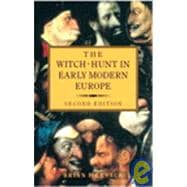
Brian Levack grew up in a family of teachers in the New York metropolitan area. From his father, a professor of French history, he acquired a love for studying the past, and he knew from an early age that he too would become a historian. He received his B.A. from Fordham University in 1965 and his Ph.D. from Yale in 1970. In graduate school he became fascinated by the history of the law and the interaction between law and politics, interests that he has maintained throughout his career. In 1969 he joined the History Department of the University of Texas at Austin, where he is now the John Green Regents Professor in History. The winner of several teaching awards, Levack teaches a wide variety of courses on British and European history, legal history, and the history of witchcraft. For eight years he served as the chair of his department, a rewarding but challenging assignment that made it difficult for him to devote as much time as he wished to his teaching and scholarship. His books include The Civil Lawyers in England, 1603-1641: A Political Study (1973), The Formation of the British State: England, Scotland and the Union, 1603-1707 (1987), and The Witch-Hunt in Early Modern Europe (1987 and 1995), which has been translated into eight languages.
His study of the development of beliefs about witchcraft in Europe over the course of many centuries gave him the idea of writing a textbook on Western civilization that would illustrate a broader set of encounters between different cultures, societies, and ideologies. While writing the book, Levack and his two sons built a house on property that he and his wife, Nancy, own in the Texas hill country. He found that the two projects presented similar challenges: it was easy to draw up the design, but far more difficult to execute it. When not teaching, writing, or doing carpentry work, Levack runs along the jogging trails of Austin, and he has recently discovered the pleasures of scuba diving.
|
vii | ||||
| Preface | viii | ||||
| Preface to the Second Edition | x | ||||
|
1 | (26) | |||
|
4 | (7) | |||
|
11 | (10) | |||
|
21 | (6) | |||
|
27 | (41) | |||
|
29 | (21) | |||
|
29 | (6) | |||
|
35 | (3) | |||
|
38 | (6) | |||
|
44 | (5) | |||
|
49 | (1) | |||
|
50 | (10) | |||
|
60 | (4) | |||
|
64 | (4) | |||
|
68 | (32) | |||
|
69 | (7) | |||
|
76 | (8) | |||
|
84 | (9) | |||
|
93 | (7) | |||
|
100 | (25) | |||
|
103 | (11) | |||
|
103 | (3) | |||
|
106 | (3) | |||
|
109 | (3) | |||
|
112 | (1) | |||
|
113 | (1) | |||
|
114 | (6) | |||
|
120 | (5) | |||
|
125 | (35) | |||
|
128 | (5) | |||
|
133 | (23) | |||
|
133 | (8) | |||
|
141 | (4) | |||
|
145 | (4) | |||
|
149 | (3) | |||
|
152 | (2) | |||
|
154 | (2) | |||
|
156 | (4) | |||
|
160 | (25) | |||
|
161 | (6) | |||
|
167 | (5) | |||
|
172 | (5) | |||
|
172 | (1) | |||
|
173 | (1) | |||
|
174 | (3) | |||
|
177 | (8) | |||
|
185 | (48) | |||
|
185 | (6) | |||
|
191 | (39) | |||
|
192 | (8) | |||
|
200 | (6) | |||
|
206 | (8) | |||
|
214 | (8) | |||
|
222 | (8) | |||
|
230 | (3) | |||
|
233 | (28) | |||
|
236 | (3) | |||
|
239 | (7) | |||
|
246 | (2) | |||
|
248 | (2) | |||
|
250 | (11) | |||
| Bibliographical Note | 261 | (9) | |||
| Bibliography | 270 | (15) | |||
| Map | 285 | (3) | |||
| Index | 288 |
The New copy of this book will include any supplemental materials advertised. Please check the title of the book to determine if it should include any access cards, study guides, lab manuals, CDs, etc.
The Used, Rental and eBook copies of this book are not guaranteed to include any supplemental materials. Typically, only the book itself is included. This is true even if the title states it includes any access cards, study guides, lab manuals, CDs, etc.